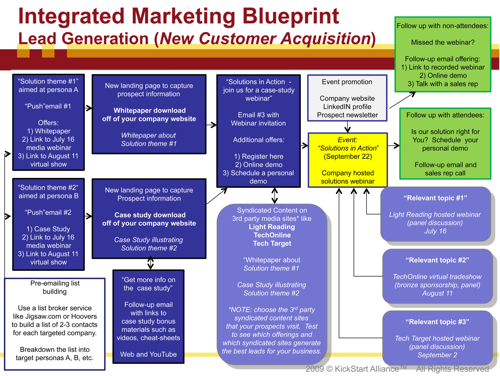4 Steps To Break Down An Effective Blueprint For Lead Generation
- Published in Demanding Views
 However, we can take a look at how the key components of a lead generation blueprint interact and play in concert with each other. The success of a lead generation program is not because of one single marketing element (e.g. a great Webinar). Instead, it’s about the combination of all of the marketing activities and offers and how they work together to engage the prospect and guide them through (or out of) the lead flow funnel quickly. The best way to see this is through an example.
However, we can take a look at how the key components of a lead generation blueprint interact and play in concert with each other. The success of a lead generation program is not because of one single marketing element (e.g. a great Webinar). Instead, it’s about the combination of all of the marketing activities and offers and how they work together to engage the prospect and guide them through (or out of) the lead flow funnel quickly. The best way to see this is through an example. The most effective lead generation programs use a combination of “push” and “pull” activities. A “push” activity is defined as one where your marketing or sales team sends (or pushes) carefully crafted messages and offers to a pre-defined list of prospects. This could be a broadcast email with a generic offer to your prospect database or a rented opt-in list, or it could be a carefully crafted message produced with a single, specific person in mind. Either way, “push” activities are about one-on-one marketing.
The most effective lead generation programs use a combination of “push” and “pull” activities. A “push” activity is defined as one where your marketing or sales team sends (or pushes) carefully crafted messages and offers to a pre-defined list of prospects. This could be a broadcast email with a generic offer to your prospect database or a rented opt-in list, or it could be a carefully crafted message produced with a single, specific person in mind. Either way, “push” activities are about one-on-one marketing.
But “push” activities are not enough. Consider that 90% of the average buying process is conducted without the aid of a sales rep. When buyers are looking for a solution, usually the first step is searching for information on the Internet. This means that your business must be “findable.” However, being findable is more than just having a Web site. It’s about posting and syndicating relevant content that pertains to the business problems the prospect is trying to solve, and having this content posted in places where the prospect visits. “Pull” activities are those that highlight your expertise and differentiation in a less sales-invasive manner and invite prospects to raise their hands to request additional information from you. These activities are also a form of nurturing prospects because, through these activities, your brand and products will continue to be promoted, thus reinforcing the awareness of your solutions.
Breaking down the Blueprint
There are four components in the lead generation blueprint graphic listed here. Let’s break them down.
- The “Push” activities (in dark blue). As I’ve already mentioned, the primary push activities are commonly the direct emails a marketing or sales team sends to prospects. But beware: the quality of lists is highly suspect today because of the volatile economy and the many rounds of lay-offs and reorganizations taking place. We’ve found that much higher ROIs are achieved when a company invests in building and nurturing their own list or targeted personas. If yours is a small business or you’re a startup, take the time to identify target companies and targeted decision makers within each company you want to reach. Use tools like Jigsaw or Hoovers to help you build your list. Then, search each prospect’s Web site; read their current press releases; find out what events they are attending. Look for a connection between their needs and your solution. If you have multiple offers, divide your list in order to perform some tests to determine what offer works best. In this example shown in the illustration, the company is testing the value of a whitepaper versus a case study. (Since we’re trying to establish a connection with a target prospect for the first time, don’t blast them with a datasheet – this assumes they already know you and understand how they might use your product.) First, establish relevance by showing that you understand their business/operations/technical problem. If they don’t know who you are, they don’t (yet) know how to value what products you provide. Take a solutions-focused approach to invite them to get more information from you.
- The “pull” activities (light blue). “Pull” activities are especially useful in driving awareness and interest with decision makers who you do not know. Since most of the buying process happens behind the scenes, you want to have a presence on the websites that decision makers use to collect information. This is where syndicated content on 3rd party media sites can make all the difference. Avoid the temptation to discredit these sites because you can’t control who has access to this information. These pull mechanisms work to your advantage by giving you more places to host relevant content, to participate in industry panel discussions, and to interact via virtual tradeshows. As a bonus, many of these media sites will guarantee you a pre-determined minimum number of “leads” (these are really unqualified names); regardless, these activities are more cost effective ways of extending your reach and promoting a richer awareness of your solutions than if you only chose to promote your own company-sponsored events and activities.
- A company-hosted event (yellow). Once the push and pull activities are in place, the question is, “what happens next?” You’ve proactively engaged with members in our prospect database on your list, and you’ve offered several pieces of relevant content on third party media sites. While this is good, it is not sufficient to guarantee you’ll receive any leads that meet your level of qualification. To do that, you need another offer to entice all prospects to take the next step with you. In this example, I’ve suggested a company-hosted Webinar may make sense. Why not execute a Webinar first? Why wait until later in the cycle? Waiting to host a Webinar now works to your advantage because you’ve now gained awareness with a larger pool of prospects, and you can promote the Webinar through more channels than if you relied solely on your push activities. While I’ve suggested the Webinar be a “solutions in action” Webinar, the topic must be relevant to your sales process. Of course, to register for the Webinar you can ask additional qualification questions on the landing page.
- The follow-up (green). Once the Webinar is over, your lead generation program is not yet complete. Many companies make the mistake of taking the names of all the registrants and immediately handing them to the insides sales team for follow-up. This mixes the good leads with the bad and can set the wrong expectations on the true quality of the leads. Instead, there is one more best-practice: Within 24 hours of the conclusion of the Webinar, break the list of registrants into two groups: those who registered and attended, and those that registered but failed to attend. Each follow-up email needs its own precise call to action. For those who registered and attended, the expectation will be that those leads may indeed be more qualified simply because the prospect has sought out information about your company/products several times already. The prospects that registered but failed to attend should be nurtured again and placed back into the lead gen funnel.
Building your own blueprints
This is only one example of a lead generation blueprint. There are many other forms to consider, and the limits are only those of your imagination. While the approach illustrated here has worked for many teams KickStart has worked with, it may or may not be appropriate for your business. Before you jump to any tactics (such as a Webinar), it’s always a good practice to confirm your marketing objective and your lead generation strategy. With a firm foundation in your objective and strategy, the right marketing activities and offers will be easier to define. Good luck and good marketing.
For more information on awareness and lead generation programs, please visit my blog: Marketing Campaign Development or follow me on Twitter.
Mike Gospe leads KickStart Alliance’s marketing operations practice where he conducts team-based “practical application working sessions” to improve the effectiveness of lead generation campaigns and product launches. His fun, practical approach and roll-up-his-sleeves attitude energizes teams, helping them to get “real work done” while guiding them to the next level of excellence. Mike is the author of the book, Marketing Campaign Development, and his methodology is being used by San Francisco State University’s College of Extended Learning course: “Essentials of Integrated Marketing.”

